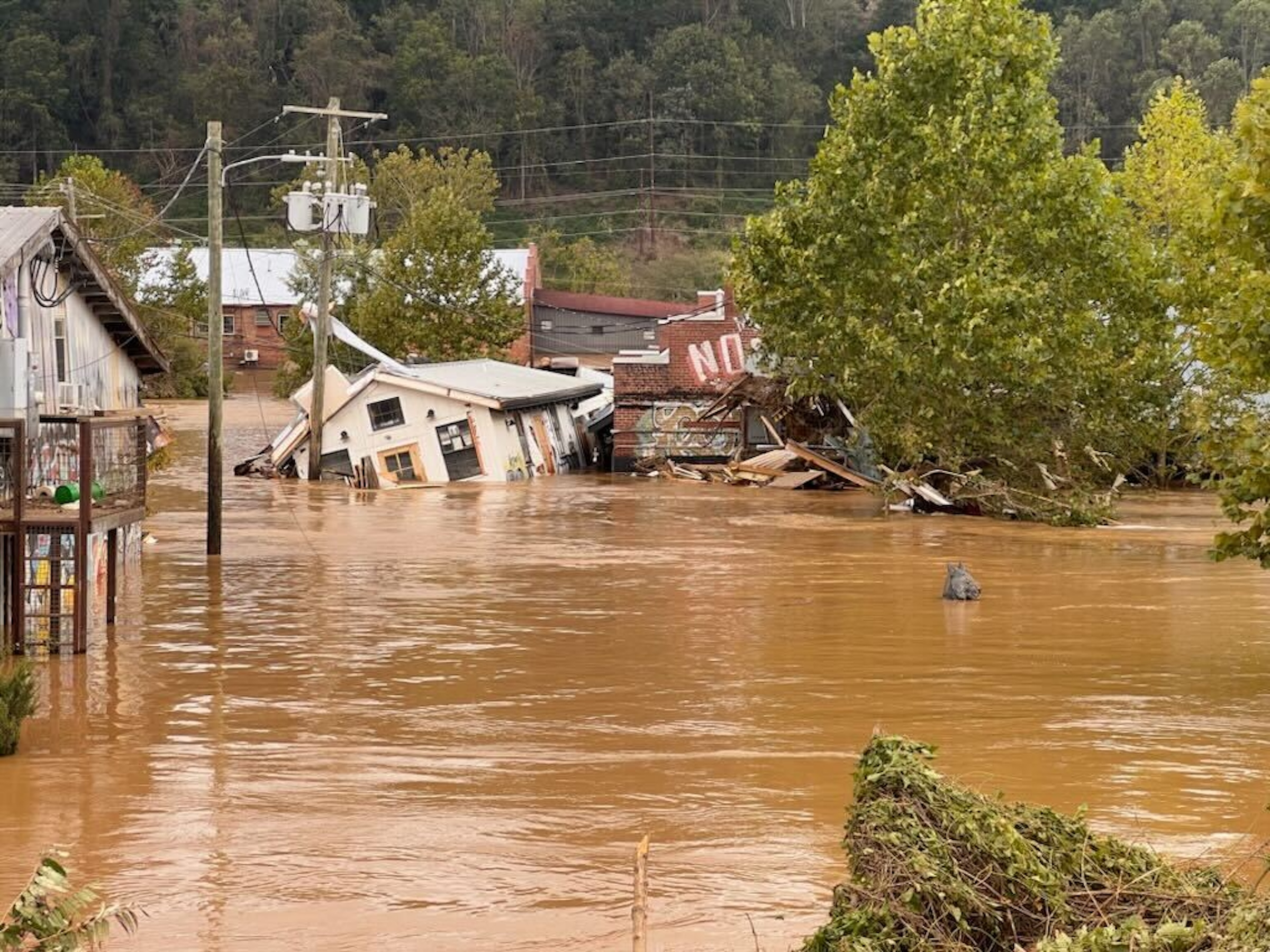Southeastern states are reeling from catastrophic loss and damages after Hurricane Helene tore a deadly path of devastation from Florida’s Big Bend region up through inland Georgia, the Carolinas, and Tennessee. In the mountains of western North Carolina, the city of Asheville was particularly hard hit by flooding from the French Broad River last Friday, September 27, obliterating the cherished River Arts District (RAD) — a creative hub home to studios, galleries, community spaces, and other artist-run small businesses.
“Two-thirds of the district has been destroyed,” said Jeffrey Burroughs, president of the River Arts District Artists Association, in an interview with Hyperallergic. Hosting over 350 local artists and craftspeople, the RAD complex comprises 27 buildings that span just over a mile of the eastern riverside. The southernmost string of buildings along Foundy Street, including the enormous Marquee warehouse which was once a bustling marketplace for artisans and antique dealers, are “gone,” according to Burroughs, who has been surveying the damages onsite daily since Friday.

The river’s record-breaking swell came after two days of torrential downpour that struck Asheville as Helene climbed further north. Up to 12 inches of rain pummeled Buncombe County between Wednesday and Friday, leaving the ground saturated, soft, and unable to mitigate the rush of stormwater that destroyed everything in its path. Buncombe County has reported over 40 confirmed deaths related to the storm, with hundreds of people unaccounted for as the state embarks on various search and rescue missions amid downed trees and power lines, gas leaks, sinkholes beneath roadways, mudslides, and a lack of running water and electricity, among other critical resources.
“Marquee is rubble, the nearby winery has washed away … It’s completely apocalyptic,” Burroughs said. He recalled overseeing artwork, art supplies, and cans of beer being carried off by the water on Friday itself, saying that it was like “watching the spirit of Asheville being washed away.”
A little further north at Pink Dog Creative on Depot Street, Asheville artist Heather Divoky, a marketing co-chair for RAD, told Hyperallergic that she had gone down to survey the damages on Monday, September 30, and called the situation “grim.”
“This will absolutely reshape RAD — we’re going to be forever changed,” Divoky said. “We’re all in complete shock right now. I don’t know how many of us can come back.”

Down the street, Trackside Studios reported that flood waters reached the ceiling of the first floor where about 40 of the 60 studio artists maintain their practice. Co-owners Julie Bell and Michael Campbell were out of state during the storm, and have since become a communications switchboard as they have reliable internet access and power. Bell noted to Hyperallergic that Trackside Studios had recently completed a months-long renovation prior to the storm to restore the building’s historic appearance.
Bell said that some artists volunteered to move salvageable artworks and supplies to the second floor, which is in far better condition. Bell, a nurse who was deployed to Biloxi, Mississippi after Hurricane Katrina, said the photos and video coming out of Asheville “evoke some visceral memories.”
“It’s so dangerous to clean up after these types of disasters because the mud is full of debris, mold spores, sharp objects, and dead fish. It’s neither safe nor sanitary,” she said.
Bell and Campbell don’t know when they’ll be able to return to Asheville.

Miles east of RAD, artist, tax expert, and Hyperallergic contributor Hannah Cole reported that her studio along the Swannanoa River tributary had been entirely upheaved by floodwaters.
“The building is totaled,” Cole told Hyperallergic, noting that 20 years worth of artwork and supplies were “effectively put in a blender for hours” in a mixture of water, mud, heavy furniture and tools, and other debris carried in by the river.
“Some level of flooding is normal during big storms, but this has never happened before,” Cole continued, adding that when she paid a risky visit to the studios after Helene, the water lines were up to the ceiling.
Ruby Lopez Harper, executive director of the Craft Emergency Relief Fund (CERF+), which imparts safeguarding advice for natural disasters and offers emergency relief and preparedness grants to artists across the United States, told Hyperallergic that “recovery is going to take years.”

“We tell artists to store their things in waterproof bins and other such protective measures … None of that is going to help when your home is underwater,” she said, explaining that no one had predicted this. So far, CERF+ has only received a handful of applications for the $3,000 emergency relief grants in response to Helene, but Lopez Harper expects an exponential amount in the coming weeks.
But on the ground, both Burroughs and Cole expressed that it’s impossible to even think so far ahead while they and their loved ones are still focused on securing potable water. However, Burroughs and the other RAD board members are conceptualizing an action plan to get stipends for artist relief, recovery funds for RAD, and a clean-up effort to remove the dangers and debris onsite.
“My husband and I moved here in 2020 after I was suffering from long COVID,” Burroughs said. “There is nothing like this area, this community, anywhere else in the country. We will come back stronger.”

